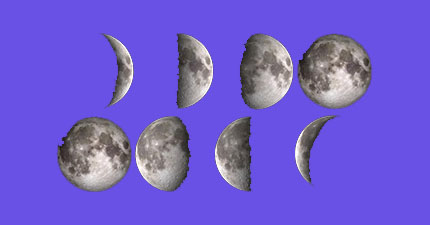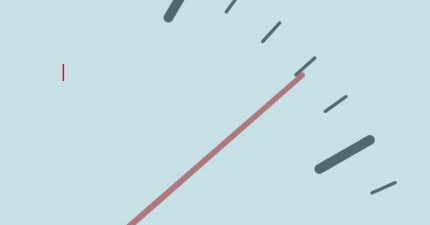So, there’s a lot of gender varieties within yaoi. Folks who grew up with yaoi will understand. A lot of the stuff popular during the early 2000s (gravitation, CUT, Viewfinder) were all pretty fucked up in terms of their willingness and also the acceleration at which they aimed to destroy gender—at the cost of destroying themselves. Not only were seme and uke a binary within the yaoi system but there also existed a binary between stories about rape that were openly aggressive towards patriarchal emotions and fluffy cutesy shit that reinforced patriarchal desires.
Gender becomes a game within yaoi. If you’ve ever seen the popular webcomic/video series “My Girlfriend is a Fujoshi,” you’ll have heard of this one: within the dynamic between a pencil and an erase, who is the seme and who is the uke?
On one hand, the eraser is able to remove everything that the pencil wants to do. On the other hand, the pencil necessarily sets the pace for all of their interactions. The eraser is not able to initiate anything on its own but relies on the pencil to tell it what to do. Of course, the pencil must live with the knowledge that everything it does must be done under the supervision and the control of the eraser.
If you had to gender a pencil and an eraser in this context, then what kind of gender would you assign it? What kind of association does your fabricated gender have? What kind of story or atmosphere does the tension between these genders hold? Which is the seme and which is the uke? The pencil or the eraser?
After you’ve played this game a couple times, you can understand the I Ching. The I Ching is a gender system, just like yaoi, but is it not a colonial gender system which means that it is fundamentally and absolutely meaningless.
Just like the hexagrams within the I Ching, the dynamics between an uke and a seme are about power. You can read several types of power dynamics within the fluctuating dynamics between an uke and a seme just like you can read many power dynamics between yin and yang.
I decided to investigate what types of uke and seme could be represented by 12 different hexagrams within the I Ching. These hexagrams correspond to the 12 sign zodiac belt, with absolute yin(broken lines)/uke corresponding to the winter solstice and absolute yang (unbroken lines)/seme corresponding to the summer solstice.
For each hexagram, I’m using the number that it’s associated with from the 64 hexagram sequence so the numbers that refer to each one will not be sequential.
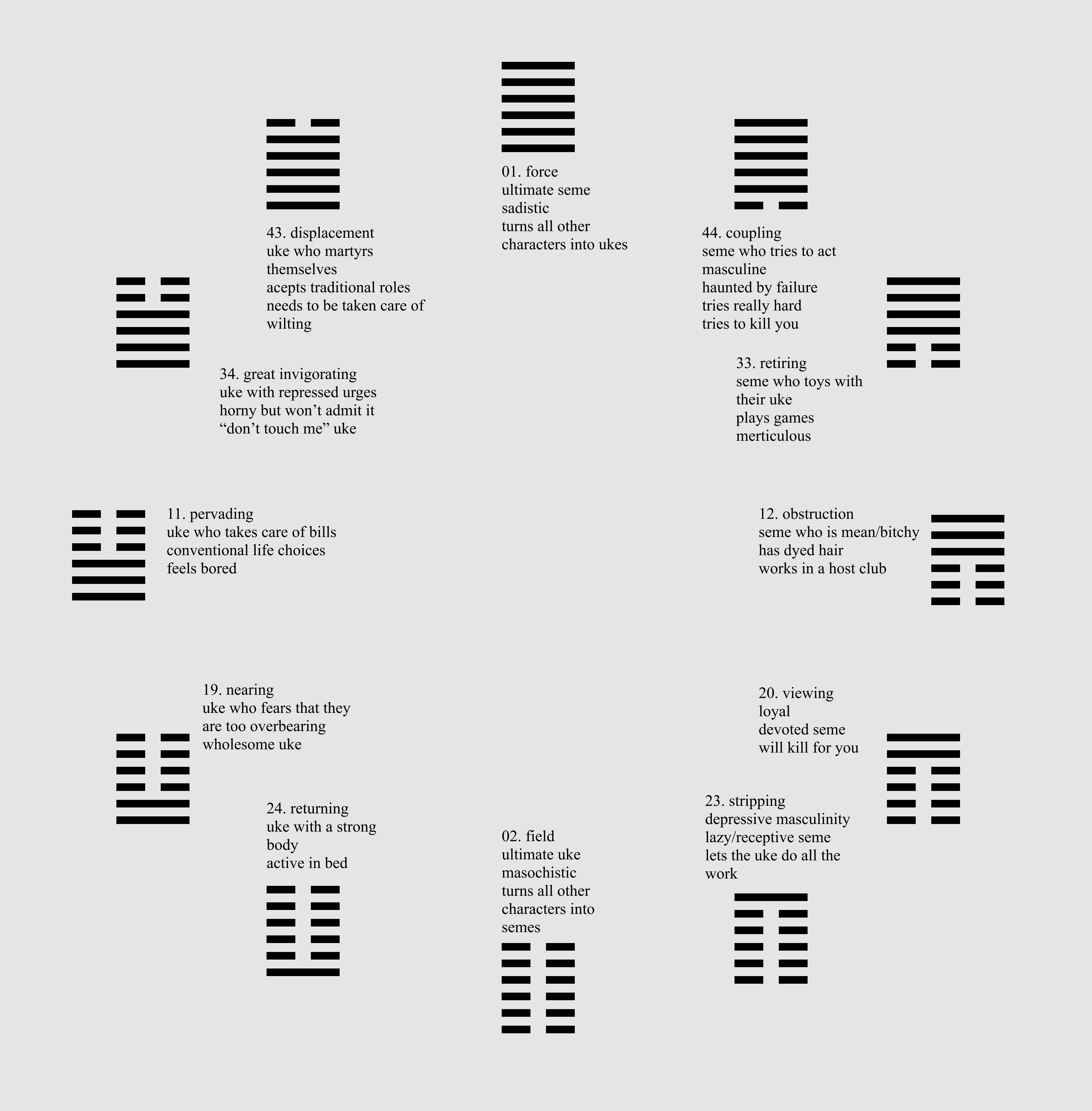
02. Field/KUN (Absolute yin/Ultimate uke)

The character who embodies Hexagram 02 is Sakaguchi from CUT by Toko Kawai. The thing to keep in mind is that absolute yin is not a weak position. Sakaguchi is a pretty strong willed character. In CUT, he experiences a lot of sexual violence and, when he pursues his love interest, he can only ask for love in a fucked up way. Instead of asking for love, he asks to be hurt. This is the ethos of the ultimate uke who turns everyone they meet into a seme. The gender ideal is a person who turns everything into a purely domineering power dynamic without having to do anything.
In terms of the I Ching, Hexagram 02 is not a bad or a good place to be. It’s the very bottom. It’s worth it to remember that, when the period of time that absolute yin represents occurs (the winter solstice, midnight, the new moon) it is not only a time of complete darkness but a time when darkness is actually diminishing and light is increasing. Once you get to the bottom, you can only rise up. Thus, the yin energy of Hexagram 02 is actually in a weaker position than the preceding hexagram even if there is more of it since it’s not rising but de-accelerating. This is why, in terms of the diagram up top, Hexagram 02 is weaker in terms of yin than Hexagram 23 and weaker in terms of yang energy than Hexagram 24.
So, Sakaguchi. Who is not a weak character but an incredibly vibrant and memorable one but someone who stands in victim.
In terms of the name, Hexagram 02 is called the field. In a purely physical way, the field accepts all the seeds that eventually become crops. It’s a fertile place. However, it’s an essentially passive place even if it’s an active place. Field can also refer to space fields as an open field for any type of activity. The field is merely a container for some type of action that will construct and define it. Thus, Hexagram 02 is the ultimate uke who seeks someone else to define its own existence.
01. Force/QIAN (Absolute yang/Ultimate seme)

An absolute seme is someone who turns all other characters within the universe into an uke. No one embodies this better than Ryuichi Asami from the Viewfinder series by Yamane Ayano. Asami is the leader of some kind of yakuza and his rivals, such as Fei Long, are very dominating in the storyline until they are faced with Asami’s physical presence. Fei Long, who is the leader of some Hong Kong gang, seeks Asami because Asami is the only one in the world who can turn him into an uke.
Asami is actually a very quiet and calm presence in the Viewfinder manga. If Sakaguchi, who embodies Hexagram 02 is pretty talkative and is always trying to stir up drama, then Asami really just tries to avoid drama and to retreat most of the time. As before, remember that Hexagram is a place of pure yang energy, which means that it is also the place where yang energy begins to retreat. Since we associate hotness and activity with yang, it makes sense that Asami would have a less hot and active personality as the embodiment of ultimate seme than Sakaguchi, who embodies ultimate uke. In terms of social power, however, Asami has all of it and Sakaguchi has none. These gender ideals make sense if we consider how people with a lot of power have the luxury of being calm and getting to retreat while those who suffer under the current system must constantly fill a provocative role. Hexagram 01 is the place of ultimate privilege, then, and Hexagram 02 is the place of ultimate oppression.
Hexagram 01 is also symbolized by the creative force. While Hexagram 02 was the material field or spatial plane, Hexagram 01 is the pure concept which animates the field. Thus, it has no spatial dimension and is pure idea.
24. Returning/FU
While yin energy is pretty dominant here because there is plenty of it, it’s actually decreasing in amount so it’s in a weakening condition even though there’s a lot. If yin represents the uke, then the uke is in a strong position but experiences themselves in decline. In this state, decline feels a lot like decadence since there are always elements of decay within decadent behaviors. Yashiro from Twittering Birds Never Fly by Kou Yoneda is a strong example of Hexagram 24. He’s another yakuza leader but instead of exercising his dominance in a direct way, he allows everyone under his employee to do whatever they like to him. The first thing that we learn about Yashiro is that everyone talks shit about him and that he smiles when he’s mad.
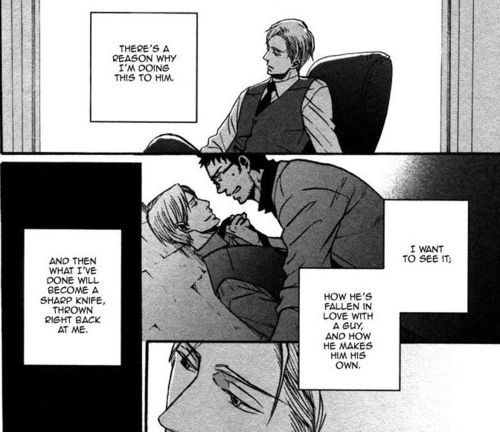
In the narrative of the manga, Yashiro is in an almost constant state of depravity and helplessness. However, the most helpless he is, the stronger he becomes since all of his yakuza relationships are masochistic instead of hierarchical. In this way, he is able to meet others who operate in a Confucian level of right or wrong face to face.
Hexagram 24 is similar to Hexagram 02. Both are ukes who ask for mistreatment but the yang energy is Hexagram 24 is a little stronger. Thus, the semes in Yashiro’s life are able to act more helpful than the ones in Sakaguchi’s life. Hexagram 24 is also known as the returning hexagram. This return is meant to be a return to an original purpose that was once lost. In this way, Hexagram 24 is about sincerity. Ultimately, Yashiro is able to survive in his world because his masochistic impulses are experienced as very sincere when contrasted to the scheming impulses of his rivals.
23. Stripping/PO
In many ways, Hexagram 23 is an inverse of Hexagram 24 (Hexagrams 43 and 44 are also inverses of them both). Hexagram 23 is just Hexagram 24 turned on its head. Yang energy small and yin energy is large. However, the main difference between the two comes from its temporality and position: while yang is increasing in Hexagram 24, it decreases in Hexagram 23. Yin decreases in Hexagram 24 while it increases in Hexagram 23.
Hexagram 23 is about a weak seme who allows himself to be overpowered by a stronger uke. This is basically Doumeki, who is also from Twittering Birds Never Fly. Doumeki is Yashiro’s employee and bodyguard but he perpetually fails at his job. Yashiro wants to sleep with Doumeki but Doumeki has erectile dysfunction. Yashiro is primarily interested in Doumeki because he’s unable to perform the sadistic roles that Yashiro is used to dealing with. As a representative of Hexagram 23, Doumeki can only define himself through failure and allow himself to be used. His yang energy is too weak and his yin energy is still growing even when it’s completely dominating to him.

The keyword associated with Hexagram 23 is disintegration or splitting. As the mirror of Hexagram 24, which is about finding the original path, Hexagram 23 is about being at a crossroads and not knowing which path to take. One road literally splits open and becomes two. Disintegration also refers to the decay of leaves that strip away trees during the cold months. Hexagram 23 does not represent the prime time for decision making as Hexagram 24 does. Rather, it’s time to simply stay put in one place and wait. Disintegrating particles become fertile when you just let them sit for a little while. Just like Doumeki, Hexagram 23 stands for a time when you’re most useful when you just do nothing.
19. Nearing/LIN
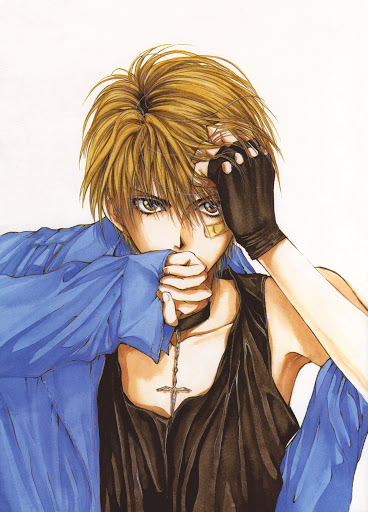
Setsuna! This is wholesome uke—uke who is so good that they can’t live in the real world, uke who will give anything and everything for the people they love. Angel uke. Of course, Setsuna from Angel Sanctuary by Kaori Yuki is this uke. Now, Angel Sanctuary is not really a yaoi but a longer cross genre manga with fujoshi elements. This means that Setsuna is not only a high school student but also a powerful angel named Alexiel who rebelled against God until she was banished to a perpetual reincarnation loop where she is violently killed over and over again. Setsuna’s character is based on his willingness to go to the underworld when his younger sister dies because they are involved in an incestuous relationship.
Since Hexagram 19 is the natural progression from Hexagram 24, it only makes sense that after you return to something, you begin to approach or near something once again. Yin energy is only slightly more than yang energy here and yang is still increasing so Hexagram 19 is a lot hotter in temperature and temperament than 24. Since Hexagram 24 was about returning to the original purpose, Hexagram 19 allows you to pursue that purpose openly. Wholesome uke always has their own goal in life that they work towards with a direct and open passion.
20. Viewing/KUAN
Hexagram 20 is really about the reversal of time. It’s about traveling backgrounds and towards another kind of eternity. What yang energy here is being actively overcome by yin, which will eventually lead to Hexagram 23 with Doumeki’s stagnant energy but we’re not quite there yet. Here, the gender ideology is still fixed to something that has grown stale and isn’t quite aligned anymore. Hexagram 20 is called viewing because it’s about taking a step backwards so that you can see the total picture. It doesn’t quite have the static feeling of Hexagram 23 but it’s almost there. It’s temperature is rapidly cooling even though it’s not frozen quite yet.
In terms of time reversals, this mirror image of Hexagram 19 is really well encapsulated by Kira from Angel Sanctuary. Remember how Setsuna was the angel Alexiel who was banished to reincarnate over and over again and die violent deaths for all of eternity? Well, Kira is the punisher who was sentenced to kill her over and over again. Of course, Kira ends up dying for Alexiel when she is reincarnated as Setsuna. The decision to commit his loyalty to a mortal rather than an immortal truth was a type of time reversal. In the beginning of the story of Angel Sanctuary, Kira actually conveys his true identity when all time is at a stand still.
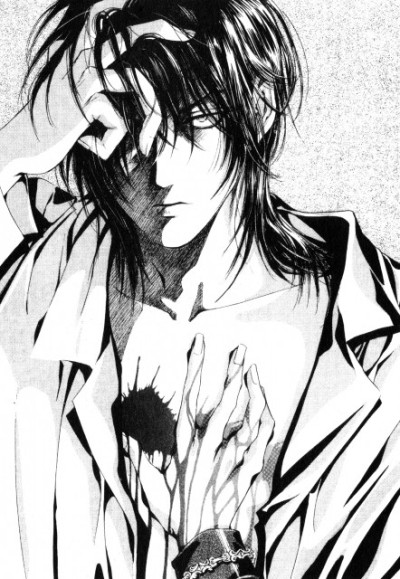
As a gender ideal, Hexagram 20 stands for the type of seme who is endlessly devoted. In order to express the depth of this loyalty, the narrative always calls on him to resist a loyalty to someone who is more powerful. At the fundamental level, focused loyalty must be expressed through the betrayal of something larger. Hexagram 20 is about a shift in perspective and the choosing to reverse a kind of time flow when you make the decision to respond instead of react in terms of how you embody generational trauma. It is a devoted ideal but an intentionally devoted ideal.
11. Pervading/T’ai
This is the sign of the spring equinox, when the amount of cool and stagnant air is equal to the amount of hot and active air. Hexagram 11 represents a time when the yang air is increasing in amount and rising to the surface—the three unbroken lines are underneath the three broken lines. In I Ching, it is much better for yang to be under yin since this forces the two ideals to flow towards one another and consolidate rather than separate and fall apart (it is in yang’s nature to go up and in yin’s nature to fall down). This is why Hexagram 11 has such a peaceful and relaxed energy. Everything where it should be and disparate elements tend to coordinate with one another.
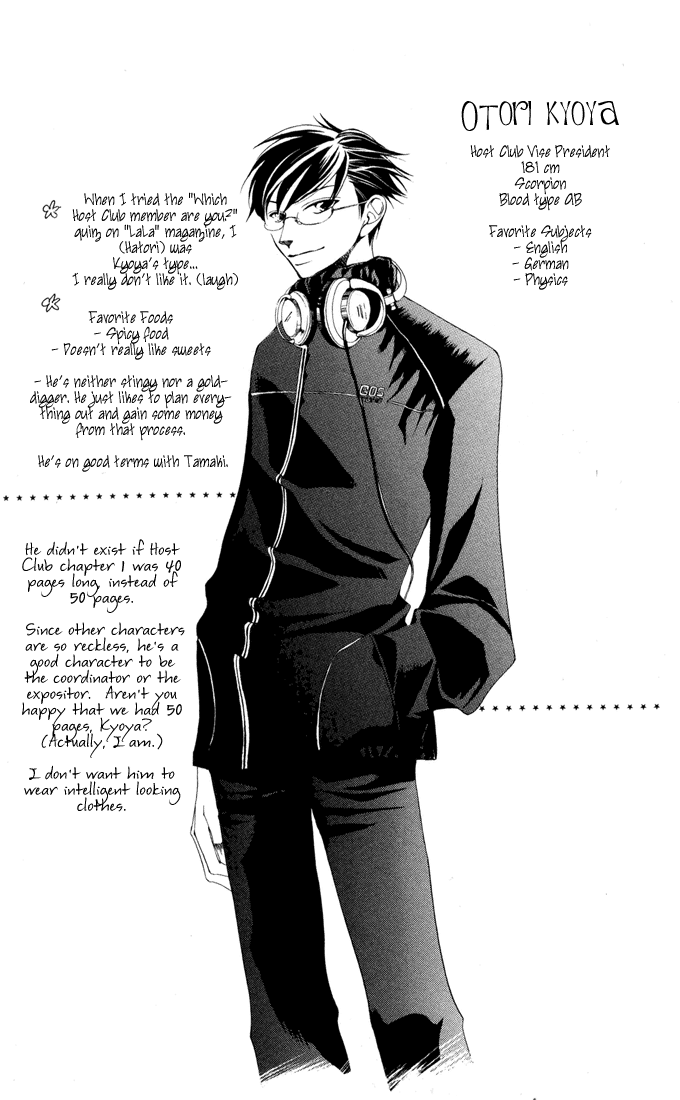
Kyoya from Ouran High School Host Club represents Hexagram 11. Not only does Kyoya’s temperament match the cool temperature of Hexagram 11 but his life story is also about a younger brother who rises up. Kyoya feels overshadowed by his overachieving older brothers but, instead of letting the situation kill his ambitions and personality, Kyoya treats the situation as a game and finds his own way to make himself shine. This is like the yang energy on the bottom of Hexagram 11 that rises up. As a host, Kyoya is also extremely capable and plays the role of a detached mother in the club.
Hexagram 11 is really about the type of uke who makes conventional life choices and is really good at playing the role that they’re supposed to play. However, because they’re able to acknowledge their hidden impulses without hurting themselves, they’re able to add an interesting flair to the roles they’re assigned and increase their effectiveness in unconventional ways. Sometimes, this type of uke grows bored because they’re smarter than the role that they have to play and they can toy with their friends and enemies.
12. Obstruction/P’i
Hexagram is all about the fall equinox, which is a time when the cooler yin air is settling on the ground and the only hotness in the atmosphere comes from an overly dry sun. As a reflection of this atmosphere, the three unbroken lines that represent yang energy are on top of the three broken lines that represent yin. Hexagram 12 is the mirror image of Hexagram 11. In yang and yin were forced to reckon with one another in Hexagram 11, then they peel away from each other in Hexagram 12 and are unable to accept one another. Moreover, yang energy positioned on top of yin is a negative significator since this means that yang will enforce a hierarchical and domineering dynamic onto yin—when the opposite happens in Hexagram 11, power dynamics tends to be more cooperative since yin does not force others to act in any specific way.
Both Hexagram 11 and 12 are about the ways you might play social roles. While Hexagram 11 was about reinvention through cooperation, Hexagram 12 is about split personalities. The obstruction keyword related to Hexagram 12 is like a giant stone that cuts you into two. The stone stands for the weight of oppression. When you feel that there are giant burdens, great expectations, and immovable limitations placed onto you, you split your personality into in order to keep a version of yourself secret from the outside world.
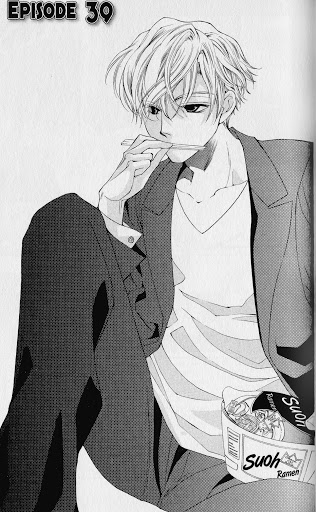
Tamaki from Ouran High School Host Club represents this gender ideal. He is a seme character since he thinks of himself as the patriarch of the host club (and Kyoya, who is his mirror image, as the matriarch). However, unlike Kyoya who integrates his dissatisfaction with the outer world into the games that he plays, Tamaki splits his personality into two separate and disjointed pieces. Tamaki’s brand within the host club is that of a polished and elitist princely type. However, his authentic personality outside of this role is awkward and hyperactive. Tamaki acts this way because his upbringing in two different cultures that don’t know how to speak to one another has forced him to assimilate into social roles by keeping other parts of himself hidden. Tamaki literally has another identity, Rene, that he only assumes in France. This split personality is reinforced by the forced splitting of Tamaki’s parents, due to his grandmother’s iron presence and her commitment to controlling the business interests of the family. In this way, Tamaki’s grandmother acts like a heavy stone and divides him into two.
As a gender ideal, Hexagram 12 is the type of really spicy seme that keeps acting out of passionate emotions such as anger or desire. They can act quite cruel sometimes because the ways that they define their own attractiveness is completely at odds with the ways in which they seek their desires.
34. Great Invigorating/Da Zhuang
Hexagram 34 has this really determined energy. Yang energy is still on the increase and surpasses yin. However, it’s not enough to make yin feel constrained yet and the position of yang being at the bottom still makes everything generally cohesive. Hexagram 34 is like this slightly cool exterior with a hot and determined interior. It has a purpose and commits towards achieving it no matter what.
Since this hexagram is about power, it makes sense to pick a young character to represent it in terms of a gender ideal. Ritsuka from Loveless by Yun Koga is a sixth grader who is traumatized when the burned body of his older brother shows up seated at his desk in school after his lunch break. The entire manga is the story of Ritsuka attempting to solve the mystery of his brother’s death. As Ritsuka battles and engages with different characters, he’s willing to go through severe lengths in order to achieve his goal. In Loveless, Ritsuka is the sacrifice to his fighter unit and takes all the damage. In terms of personality, Ritsuka frequently declares that he doesn’t need or want friends. It seems as he is dedicated to being a misfit and resists any kind of social interaction.

Ritsuka is a committed presence because he is struggling to hard to reach his goal despite the unsolvability of his brother’s murder. He has a hot core temperament because he must sustain this type of energy to continue to pursue his goals even though he is a powerful kid in an adult world. Ritsuka’s character is of someone who is thrown into a place in a world that he is ultimately resistant to. He wants to disobey the rules surrounding fighter-sacrifice units in his world. This is why he has to draw upon his inner strength.
It’s also worth it to note that, in contrast to the ukes that came before the equinox representing Hexagrams 24 and 19, Ritsuka is not really a masochist. Hexagram 34 is much more about struggling against something outside of yourself and by swallowing your losses rather than punishing yourself in order to avoid conflict.
33. Retiring/Tun
If Hexagram 34 is about an increase in power, then Hexagram 33 is about a decrease in power. Remember—Hexagram 33 is the hexagram that eventually leads to Hexagram 12, which is the great obstacle. It is about walking away and disengaging. Yin energy is on the bottom here and it is weaker than yang. It’s in a position of subservice. However, yin is actively increasing while yang is decreasing even though there is more of it. Due to this, the manipulation potential of Hexagram 33 is high. When yin is in a subservient and detached position, it seeks to manipulate from a position of powerlessness in order to gather more support.
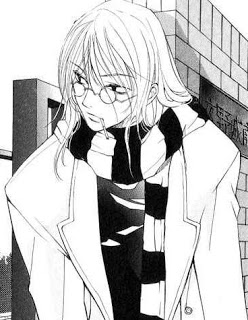
Soubi in Loveless represents the gender ideal of the manipulative seme. In Loveless, Soubi is the fighter half of his and Ritsuka’s fighter-sacrifice unit. However, they did not choose one another. Soubi fought for Ritsuka’s brother and was told to find and fight for Ritsuka after Seimei, Ritsuka’s brother, was murdered. Throughout Loveless, Soubi seems to manipulate Ritsuka into a new reality. He stalks Ritsuka at his new school, spends time with him, defends him against predators, lets Ritsuka pierce his ears, tells Ritsuka that he’ll do anything Ritsuka wants him to do, and lies to Ritsuka. Since Soubi represents the retiring hexagram, he is without a goal or motive of his own. His entire character is based on how other people mold him. First, his trainer treated him like a slave and then Seimei chose him and continued that kind of treatment. Soubi seeks a similar type of treatment from Ritsuka.
As a gender, Hexagram 33 represents a meticulous and planning ideal. It’s not actively involved in any pursuit of its own but draws back in order to assess the situation. You get the feeling that Hexagram 33 only really wants the opposite of whatever it actively tries to seek.
43. Determination/Guai
Hexagrams 34 and 43 are a bit similar. Both show a decreasing yin energy that is small and on top. Both show an increasing yang energy that rises from the bottom. Thus, both hexagrams are relatively determined in its feeling. However, Hexagram 43 is the last stage before yin disappears completely and absolute yang or ultimate seme is achieved. It’s the last uke phase before we transition into the seme part of the wheel. Thus, uke is in a position of total victimization here. If Ritsuka was a child in an adult world who is completely incapable of understanding that world, then yin is even more exploited in Hexagram 43. Hexagram 43 wants to martyr itself and seeks total self destruction. It lives in a world where it cannot exist. It feels self hatred because it blames itself for its own problems and feels that its obstacles are self creations.

In Kaori Yuki’s story Boy’s Next Door, Lawrence is a fourteen year old who is being trafficked by his brother. He is characterized as being callous and whimsical. Lawrence’s only motive in the manga is self destruction. He wants his main love interest, Adrian, to kill him and to eat the body. Throughout the manga, he knows exactly what he wants and even goes so far as to blackmail Adrian to achieve his purpose.
44. Coupling/Gou
Hexagram 44 has often been compared to the anima within western psychology since it shows a waxing crescent yin that rises in power but is still relatively slim. However, in a Confucian framework, Hexagram 44 has more to do with birth and children in general. Remember—yang is purely ideology and does not work with matter at all. This first slice of yin that emerges after the total yang diagram of Hexagram 01 is the first birth and the heir. This is why the keyword attached to Hexagram 44 is coupling. It’s pure creation—the making of something out of nothing.
Like a first born heir, Hexagram 44 is dealing with being shaped by ideological forces all around it just like Hexagram 43. However, while material reality is being extinguished and martyred in Hexagram 43, yin is emerging in Hexagram 44. Material reality is just beginning to take shape. This is a crucial moment and Hexagram 44 is like a hard worker who fears the world around it while impulsively acting. It can try really hard to fulfill certain identities. While Hexagram 43 is afraid of success since it seeks to dissolve itself, Hexagram 44 is afraid of failure and seeks to create a new cycle.

Adrian, who is Lawrence’s lover in Boy’s Next Door, is a serial killer who murders young boys by night and teaches at a kindergarten by day. Adrian’s entire narrative is shaped by events that happened in his childhood. When his neglecting mother, who was a sex worker, was stabbed, Adrian finished killing her and spent a long period of time with the body. To prevent himself from being seen, he removed her eyes and covered all the eyes of all the photographs inside his house. As an adult, Adrian helps Lawrence escape his brother by killing him. Since Lawrence asks to be murdered, Adrian sees the event as an act of love and a release from Adrian’s previous cycle of enacting his mother’s murder over and over again.
As a character, Adrian is pretty self obsessed and unable to see the world from any other perspective except his own. The new cycle that he brings is ultimately an enforcement of his own will onto another. Adrian, as a representative of Hexagram 44, is a sadist who seeks consequences for his actions. He wants to be punished for his crimes because he wants to be punished for his original murder. In this way, Adrian differs from the archetype of ultimate seme represented by Asami since Asami does not seek to experience consequences. While Asami only punishes, Adrian seeks to be punished while also punishing others.
Comparing Hexagrams 23 and 24 with 43 and 44
Again, both Lawrence and Yashiro, representing Hexagrams 43 and 24, seek to destroy themselves. However, Lawrence seeks self destruction as a result of his external condition. He is literally trapped and he thinks that death is the only way out. Yashiro, on the other hand, is only trapped in his heart. He has a large amount of power in the outside world but tries to recreate his trauma events over and over. While Yashiro is masochistic, Lawrence is only idealistic.
Both Doumeki and Adrian, representing hexagrams 23 and 44, are savior seme types who killed their parents. Adrian killed his mother and Doumeki killed his stepfather for assaulting his younger sister. After they become adults, they both have a type of savior complex and think that they can only achieve heroism through violence. However, while Adrian is sadistic, Doumeki is basically a service dom.
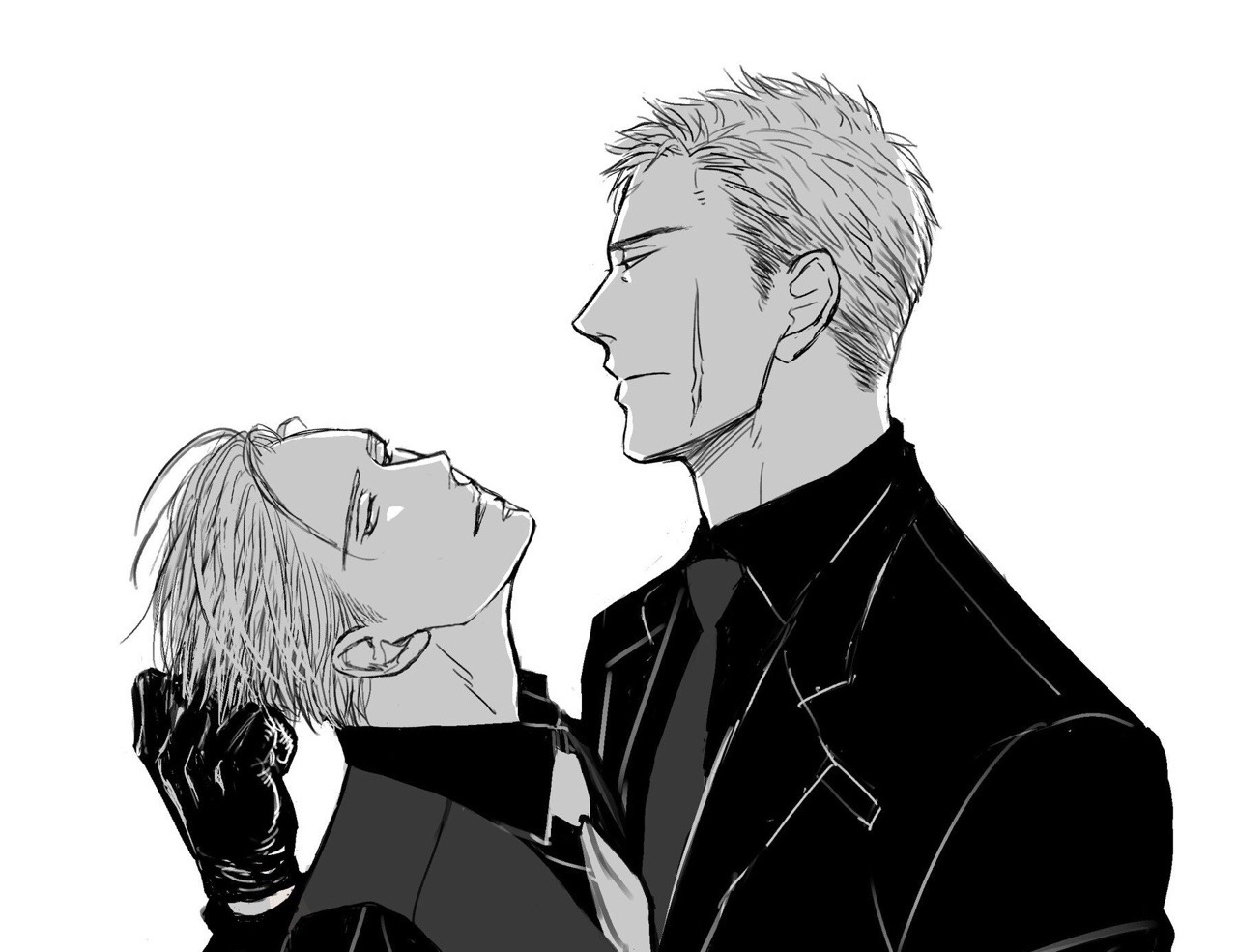
All four hexagrams deal strongly with themes around dominance and submission. This is because all four hexagrams are images that show a dominance of one energy and either a retreat or an emergence of another type of reality. The power dynamics between yin and yang are extremely unequal in all four hexagrams. Hexagrams 23 and 24 mirror Hexagrams 43 and 44 since they show unequal power dynamics with different types of rhetoric.
Comparing Hexagrams 19 and 20 with 33 and 34
All four of these hexagrams are ultimately about trust. While Ritsuka and Setsuna, representing Hexagrams 34 and 29, are both ukes who have a strong motive, Soubi and Kira, representing Hexagrams 20 and 33, are their antagonists and sidekicks.
However, the main difference between the relationship between 19 and 20 with 33 and 34 is that Kira was sent to stay by Setsuna/Alexiel’s side in order to kill her over and over. He was supposed to punish or betray her. However, he makes the personal decision to give his life to support Setsuna. Soubi, on the other hand, is sent to Ritsuka’s side by Seimei’s will, which says that Soubi belongs to Ritsuka in the event of Seimei’s death. On the surface, Soubi seems like a helper but, in a closer reading, he seems to only deceive and alienate Ritsuka away from authority figures even more.
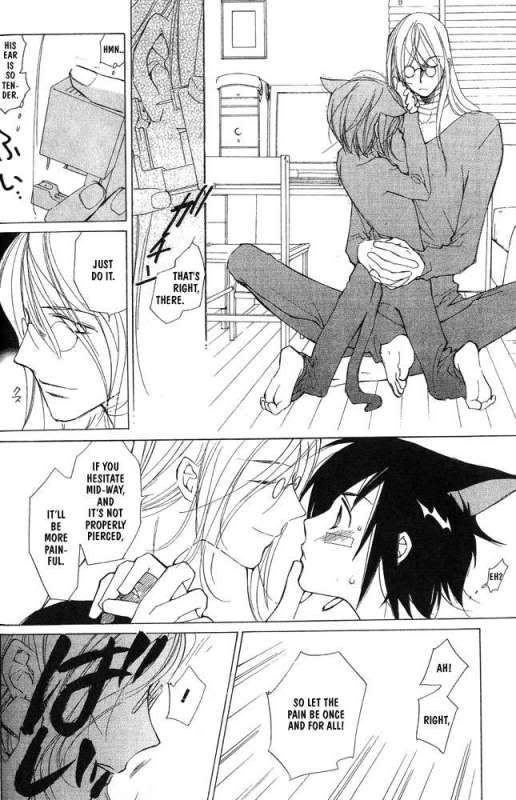
It’s worth it to note that neither Kira nor Soubi tell the truth and that, in both cases, trust is built from lies out of decision making and not truth telling. Since Hexagrams 19, 20, 33, and 34 show a dynamic that is trying to find a balance in which one type of energy is almost equal to the other but not quite there, they talk about themes such as alliance and trust.
Comparing Hexagrams 01 and 02 with 11 and 12
These four hexagrams are basically about social roleplaying and gender as social performance. We already got into the type of social role playing that Hexagrams 11 and 12 represent in terms of peer to peer relationship—we talked about how Kyoya is able to integrate the disparate parts of his persona into a competitive struggle while Tamaki split his own personality into two pieces.
Hexagrams 01 and 02, represented by Asami and Sakaguchi, are about seniority. Both characters emerge from their familial contexts—Asami from the yakuza background where he serves as leader and Sakaguchi from his nuclear family background where he is sleeping with his stepfather. Thus, Hexagrams 01 and 02 show power dynamics between older and younger members of society while Hexagrams 11 and 12 show games of hide and tell between members of equal ranking.
